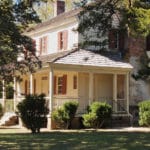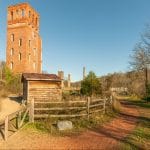Spartanburg Taking to the Skies
By Sharon Purvis, produced in cooperation with the HubCity Writers Project.
When Charles Lindbergh visited South Carolina on his tour of the 48 states following his historic Atlantic crossing in 1927, he came to Spartanburg for the simple reason that it was, at the time, the only airport in the state.
I had flown into and out of Greenville-Spartanburg International Airport many times, but had never been to Spartanburg Memorial Airport, so I took a visit one day in the summer of 2015 to see where Spartanburg aviation history started.
It’s easy to guess that Josh Shackley—officially Lead Master Tech, and unofficially, resident historian—has given the tour many times before, usually to school groups. He easily drops names and dates into his talk, interspersing colorful anecdotes with historical facts. The tour is aided visually by the large oil paintings that hang on the walls from the entrance to the stairwell to the upper floors, which house offices and the flight tower. The intricately detailed paintings (“Look at the cigarette—you can see fire!” Shackley says) were painted by Robert Wilson, a self-taught artist from Woodruff.
Prominently placed in the entrance is a large portrait of a group of World War I pilots, including one of the most famous and decorated fighter pilots of that war, Eddie Rickenbacker, and Spartanburg native Robert Z. Cates.
 It was the forward-thinking Cates who, in 1920, suggested to the Spartanburg City Council that the city should build an airport, even if it would be years before it had any commercial use. The Council readily agreed—and put Cates in charge of the undertaking.
It was the forward-thinking Cates who, in 1920, suggested to the Spartanburg City Council that the city should build an airport, even if it would be years before it had any commercial use. The Council readily agreed—and put Cates in charge of the undertaking.
The land selected as the ideal site for the airport now sits in the middle of residential neighborhoods, but at the time, it was a cotton field, which was purchased by the city in 1926.
The earliest practical use for the new aeronautical technology, outside of war, was the delivery of mail, and Cates, along with fellow aviation committee members J. C. Grier and Major B. Manning, led a successful campaign to get Spartanburg on the postal route between Washington, DC and Atlanta. Although the airport didn’t open officially until September 10, 1927, the postmaster general had designated Spartanburg as an official postal stop in March of that year, citing its location and its proximity to potential air mail users for the decision.
 The airport barely had time to work out the kinks of operation before the excitement of the Lindbergh visit took over the city. Indeed, given all of the preparation that went into an event of such importance, it is likely that planning was taking place before the airport was officially open.
The airport barely had time to work out the kinks of operation before the excitement of the Lindbergh visit took over the city. Indeed, given all of the preparation that went into an event of such importance, it is likely that planning was taking place before the airport was officially open.
A 20-page souvenir program was produced that includes photos, maps, and advertisements, as well as a warm welcome to “Lindy.” Lindbergh’s day was structured from the time he landed at 1:30 in the afternoon: A short ceremony at the airfield was followed by a parade, culminating in an address at Duncan Park from Lindbergh on the subject of commercial aviation, which was in its infancy but about to change the face of transportation. In the evening, Lindbergh was the guest of honor at a dinner in the dining room at Converse College.
Other luminaries to visit Spartanburg by way of the airport included Amelia Earhart, who spoke at Converse College about women in aviation in 1931; Eleanor Roosevelt, campaigning for her husband in 1932; and Admiral Byrd, who flew into town to meet with textile manufacturers the Reeves Brothers about making some fabric that would keep him warm on his North Pole expedition.
 In the 1950s, as commercial aviation grew as an industry, planes got bigger too, requiring longer runways than could be accommodated at either the Spartanburg or the Greenville municipal airports. In 1958, a task force led by textile leader Roger Milliken presented a proposal to Spartanburg and Greenville counties for a joint airport in Greer, halfway between the two cities. Greenville-Spartanburg Airport opened October of 1962, and in 1995, shortly after the coming of the BMW factory, it was renamed Greenville-Spartanburg International Airport. In 2004, the airfield was named the Roger Milliken Airfield to honor the man who was, according to the GSP Airport website, “founder and only Chairman of the Airport Commission until his passing on December 30, 2010.”
In the 1950s, as commercial aviation grew as an industry, planes got bigger too, requiring longer runways than could be accommodated at either the Spartanburg or the Greenville municipal airports. In 1958, a task force led by textile leader Roger Milliken presented a proposal to Spartanburg and Greenville counties for a joint airport in Greer, halfway between the two cities. Greenville-Spartanburg Airport opened October of 1962, and in 1995, shortly after the coming of the BMW factory, it was renamed Greenville-Spartanburg International Airport. In 2004, the airfield was named the Roger Milliken Airfield to honor the man who was, according to the GSP Airport website, “founder and only Chairman of the Airport Commission until his passing on December 30, 2010.”
 Today, the smaller Spartanburg airport caters to corporate and private planes, and three flight schools operate out of the facility, while GSP International continues to enhance its commercial service with recent renovations and expansions.
Today, the smaller Spartanburg airport caters to corporate and private planes, and three flight schools operate out of the facility, while GSP International continues to enhance its commercial service with recent renovations and expansions.
For a more complete history of aviation in Spartanburg, Spartanburg Memorial Airport Scrapbook: A History 1910–2011, compiled and edited by Ed Y. Hall, can be purchased at Hub City Bookshop or at the downtown airport, and several copies are available through the Spartanburg County Public Libraries.
Thanks to RC&A of the Carolinas for the aerial shot. Photos by Nat Jehlen.
Sharon Purvis, Produced in cooperation with the HubCity Writers Project.
 Sharon Purvis is a freelance writer and editor who has made her way to South Carolina by way of Indiana, Colorado, Peru, North Carolina, and New York. Although she currently works from home, she’s found that writing about the Upstate is a great way to get to know the area—and there’s a lot to know.
Sharon Purvis is a freelance writer and editor who has made her way to South Carolina by way of Indiana, Colorado, Peru, North Carolina, and New York. Although she currently works from home, she’s found that writing about the Upstate is a great way to get to know the area—and there’s a lot to know.






